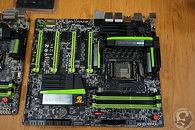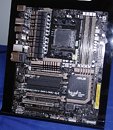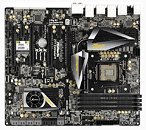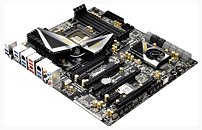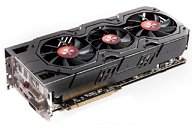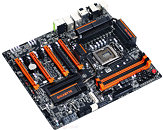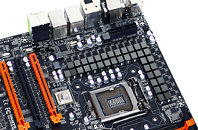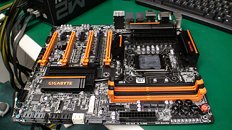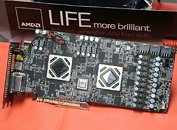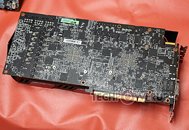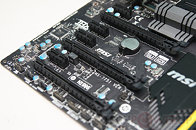Apr 21st, 2025 17:15 EDT
change timezone
Latest GPU Drivers
New Forum Posts
- NVidia 576.02 breaks GPU temperature and rpm sensor read out and use for some applications (9)
- TPU's Nostalgic Hardware Club (20267)
- Request for advice [Big Build] (15)
- RX 9000 series GPU Owners Club (446)
- PC speakers & headphones recommendations (22)
- Companies should be called out for this (11)
- 5060 Ti 8GB DOA (46)
- RTX5000 Series Owners Club (184)
- Ryzen Owners Zen Garden (7743)
- Asus Rog Dominus Extreme. LGA 3647 Xeon. (5)
Popular Reviews
- ASRock X870E Taichi Lite Review
- ASUS GeForce RTX 5060 Ti TUF OC 16 GB Review
- NVIDIA GeForce RTX 5060 Ti PCI-Express x8 Scaling
- Palit GeForce RTX 5060 Ti Infinity 3 16 GB Review
- MSI GeForce RTX 5060 Ti Gaming OC 16 GB Review
- ASUS GeForce RTX 5060 Ti Prime OC 16 GB Review
- Zotac GeForce RTX 5060 Ti AMP 16 GB Review
- MSI GeForce RTX 5060 Ti Gaming Trio OC 16 GB Review
- Teevolution Terra Pro Review
- Sapphire Radeon RX 9070 XT Pulse Review
Controversial News Posts
- NVIDIA GeForce RTX 5060 Ti 16 GB SKU Likely Launching at $499, According to Supply Chain Leak (182)
- NVIDIA Sends MSRP Numbers to Partners: GeForce RTX 5060 Ti 8 GB at $379, RTX 5060 Ti 16 GB at $429 (127)
- NVIDIA Launches GeForce RTX 5060 Series, Beginning with RTX 5060 Ti This Week (115)
- Nintendo Confirms That Switch 2 Joy-Cons Will Not Utilize Hall Effect Stick Technology (105)
- Nintendo Switch 2 Launches June 5 at $449.99 with New Hardware and Games (99)
- Sony Increases the PS5 Pricing in EMEA and ANZ by Around 25 Percent (85)
- NVIDIA PhysX and Flow Made Fully Open-Source (77)
- Windows Notepad Gets Microsoft Copilot Integration (75)
News Posts matching #PLX
Return to Keyword Browsing
GIGABYTE G1.Sniper 5 and G1.Sniper M5 Motherboards Pictured
At a media event held in its Taipei headquarters, GIGABYTE demonstrated its AMP-UP integrated audio solution that will feature on some of its upcoming motherboards. On that pretense, it even got to show of two of its top socket LGA1150 motherboards, built for Core "Haswell" processors, the G1.Sniper 5, and the G1.Sniper M5. Positioned in gamer-overclocker targeted G1.Killer series, the two boards are based on Intel Z87 Express chipset. The G1.Sniper 5 is the larger standard ATX motherboard; while the M5 is a compact micro-ATX offering. The pictures also confirm that socket LGA1150 retention module and bolt-spacing is identical to sockets LGA1155 and LGA1156.
The G1.Sniper 5 appears to feature a 16-phase VRM, which uses ferrite-core chokes, and the same International Rectifier PowIRstage components as Ultra Durable 5 motherboards from the previous generation. This time around, the CPU plays a greater role in voltage regulation. The driver-MOSFETs on the board are cooled by an active fan-heatsink, which also has a liquid channel running through it, so you could make it part of your CPU loop. Thankfully GIGABYTE didn't let its imagination run away with designs of the other heatsinks on the board, one of which cools the Z87 Express chipset, and the other we imagine, a PLX PEX8747 48-lane PCI-Express 3.0 bridge chip. This chip gets you 4-way SLI/CrossFireX support.
The G1.Sniper 5 appears to feature a 16-phase VRM, which uses ferrite-core chokes, and the same International Rectifier PowIRstage components as Ultra Durable 5 motherboards from the previous generation. This time around, the CPU plays a greater role in voltage regulation. The driver-MOSFETs on the board are cooled by an active fan-heatsink, which also has a liquid channel running through it, so you could make it part of your CPU loop. Thankfully GIGABYTE didn't let its imagination run away with designs of the other heatsinks on the board, one of which cools the Z87 Express chipset, and the other we imagine, a PLX PEX8747 48-lane PCI-Express 3.0 bridge chip. This chip gets you 4-way SLI/CrossFireX support.
PLX to Expound PCI Express as a Fabric at Linley Tech Data Center Conference
PLX Technology, Inc., the global leader in PCI Express silicon and software connectivity solutions enabling emerging data center architectures, today announced a key presentation detailing PCI Express (PCIe) use as the backbone of a data center fabric. Held next week at the Linley Tech Data Center Conference, Larry Chisvin, PLX vice president of strategic initiatives, will outline why designers are replacing Ethernet and other fabric standards with PCIe due to its high performance, low cost, low power, and simplicity. Chisvin's presentation, titled PCI Express is the Natural Next-Generation Data Center Fabric, will take place during the Fabric Technologies for Data Centers track, February 5 at 11:50 a.m.
"The interest level in using PCI Express as a data center fabric has increased significantly in the past several years, as global designers began looking for an affordable mainstream interconnect without the unwelcome baggage of the current solutions," said Chisvin. "PLX has the advanced switching technology developed through many generations of PCIe switches, and is currently developing the products that can address this market. The company is working with early adopters on its ExpressFabric solution, which includes the switches necessary for building a state-of-the-art fabric, as well as the complementary development and software building blocks."
"The interest level in using PCI Express as a data center fabric has increased significantly in the past several years, as global designers began looking for an affordable mainstream interconnect without the unwelcome baggage of the current solutions," said Chisvin. "PLX has the advanced switching technology developed through many generations of PCIe switches, and is currently developing the products that can address this market. The company is working with early adopters on its ExpressFabric solution, which includes the switches necessary for building a state-of-the-art fabric, as well as the complementary development and software building blocks."

ASUS Unveils World's First PCI-Express 3.0 Motherboard for AMD Processors
ASUS did the unthinkable yet simple, by innovating the first AMD platform motherboard that features PCI-Express 3.0 x16 slots, the Sabertooth 990FX/GEN3.0 R2.0. Long naming aside, the board provides you a couple of gen 3.0 slots by using PLX-made 48-lane PCI-Express Gen 3.0 bridge chip.
While the board features four PCI-Express x16 slots, only two similarly-colored slots can be used at a time, of which two are PCI-Express 2.0 x16, wired to the 990FX northbridge, and two slots being x16/NC or x8/x8-capable, being wired to a PLX 48-lane PCI-Express Gen 3.0 switch, which in turn takes two PCI-Express 2.0 x16 links from the northbridge.
While the board features four PCI-Express x16 slots, only two similarly-colored slots can be used at a time, of which two are PCI-Express 2.0 x16, wired to the 990FX northbridge, and two slots being x16/NC or x8/x8-capable, being wired to a PLX 48-lane PCI-Express Gen 3.0 switch, which in turn takes two PCI-Express 2.0 x16 links from the northbridge.
PLX and Kontron Announce PCI Express Fabric Breakthrough
PLX Technology, Inc., a leading global supplier of high-speed connectivity solutions enabling emerging data center architectures, and Kontron, a global leader in embedded computing technology, today announced an industry breakthrough in the deployment of PCI Express (PCIe) technology as a backplane interconnect. Built around PLX ExpressLane PCIe 3.0 (Gen3) switches, Kontron's VX3042 and VX3044 Intel Core i7-based single-board computers (SBCs) routinely achieve 5.6 gigabytes per second (GB/s) in data throughput between any boards in a VPX rack.
PLX Unveils ExpressFabric at SC12 Supercomputing Event
PLX Technology, Inc. (NASDAQ: PLXT), a leading global supplier of high-speed connectivity solutions enabling emerging data center architectures, today announced a live demonstration of its ExpressFabric technology at the SC12 supercomputing conference this week in Salt Lake City, UT. ExpressFabric is a PLX-initiated approach to extending the PCI Express (PCIe) standard from its current dominant presence inside servers, switches and storage appliances, to a central position as a fabric, uniting all hardware within the racks of data centers.
"Small to medium sized clusters -- for example, those with 20 to 1,000 CPU nodes, on one to eight racks -- are best suited for ExpressFabric technology," said Vijay Meduri, PLX vice president of engineering. "For applications that use clusters of that size, or are capable of using disaggregated clusters, ExpressFabric technology allows for complete elimination of bridges and other protocol fabrics to create the mini-clusters. The PCIe convergence model and ongoing software development that is being implemented is designed to be compatible and will co-exist with Ethernet, InfiniBand and other fabrics in the data center."
"Small to medium sized clusters -- for example, those with 20 to 1,000 CPU nodes, on one to eight racks -- are best suited for ExpressFabric technology," said Vijay Meduri, PLX vice president of engineering. "For applications that use clusters of that size, or are capable of using disaggregated clusters, ExpressFabric technology allows for complete elimination of bridges and other protocol fabrics to create the mini-clusters. The PCIe convergence model and ongoing software development that is being implemented is designed to be compatible and will co-exist with Ethernet, InfiniBand and other fabrics in the data center."

ASRock Announces the Release of its Top Tier Z77 Extreme11 Motherboard
For those who haven't taken a leap to Intel's Z77 and Ivy Bridge combo yet, either you're cultivating self discipline or you're planning to prey upon something big. Well, now is the big moment, because ASRock is releasing its beastlike Z77 Extreme11!
This tiptop motherboard has 8 SAS2/SATA3 connectors supported by an LSI SAS2308 PCIe 3.0 x8 controller. For extreme graphics, 3-Way SLI/4-Way CrossFireX is supported via a PLX PEX 8747 bridge. The LAN solution is also tempting. Two Intel LAN chips to support dual LAN and teaming, while there's also a 2T2R Dual Band WiFi & Bluetooth 4.0 module and a bundled Wi-SB Box. Specially designed for computer enthusiasts, Z77 Extreme11 possesses unbeatable hardware and extreme powers waiting to be unleashed.
This tiptop motherboard has 8 SAS2/SATA3 connectors supported by an LSI SAS2308 PCIe 3.0 x8 controller. For extreme graphics, 3-Way SLI/4-Way CrossFireX is supported via a PLX PEX 8747 bridge. The LAN solution is also tempting. Two Intel LAN chips to support dual LAN and teaming, while there's also a 2T2R Dual Band WiFi & Bluetooth 4.0 module and a bundled Wi-SB Box. Specially designed for computer enthusiasts, Z77 Extreme11 possesses unbeatable hardware and extreme powers waiting to be unleashed.

OCZ Technology Appoints Ralph Schmitt as President and CEO
OCZ Technology Group, Inc., a leading provider of high-performance solid-state drives (SSDs) for computing devices and systems, today announced its board of directors has appointed Ralph Schmitt as the Company's president and chief executive officer effective immediately. Ralph Schmitt has been a member of the Company's board of directors since April 2011.
"I am pleased to announce that OCZ's board has appointed Ralph Schmitt as the Company's president and chief executive officer," said Adam Epstein, OCZ's lead independent director. "Ralph's knowledge of OCZ's business, customers, and target markets along with his extensive management experience and technical expertise make him the ideal person to lead OCZ through the next phase of its development."
"I am pleased to announce that OCZ's board has appointed Ralph Schmitt as the Company's president and chief executive officer," said Adam Epstein, OCZ's lead independent director. "Ralph's knowledge of OCZ's business, customers, and target markets along with his extensive management experience and technical expertise make him the ideal person to lead OCZ through the next phase of its development."

Club 3D Radeon HD 7990 Graphics Card Pictured
Club 3D plans to be one of the very few AMD AIB partners with a Radeon HD 7990 dual-GPU graphics card. Its product is based on the same exact design as PowerColor's recently-launched HD 7990 base and flagship HD 7990 Devil13, since TUL (PowerColor's parent company) is the OEM of Club 3D Radeon series graphics cards. The card packs two 28 nm "Tahiti" Radeon HD 7970 ASICs with a PLX-made PCI-Express 3.0 bridge chip, and a total of 6 GB of GDDR5 memory across two 384-bit wide memory interfaces. It's likely that Club 3D's card sticks to the same clock profiles as PowerColor's HD 7990 base, with 900 MHz core, 925 MHz OC (toggled manually with a switch), and 5.50 GHz memory. More details are awaited.
PLX to Showcase Emerging PCIe Gen3, USB 3.0 Applications at Intel Developers Forum
PLX Technology, Inc., a leading global supplier of high-speed connectivity solutions enabling emerging data center architectures, is welcoming attendees of the Intel Developers Forum (IDF), held this week in San Francisco at the Moscone West Convention Center, to witness a live demonstration of how PCI Express (PCIe) Gen3 performance is poised to challenge, replace or enhance all other interconnect technologies in the data center, including SAS, RapidIO, InfiniBand and Ethernet.
The first demonstration utilizes PLX PCIe Gen3 switches to showcase plug-and-play, box-to-box connectivity using cost-effective optical modules, connectors and cables -- without any special hardware or software -- can achieve the high performance required of new data center designs. The demonstration's highlights include a x4 PCIe configuration achieving 32 Gbps throughput via economical mini-SAS HD or dual-optical USB. The demonstration will also prove how "independent SSC" operation can be achieved without spread-spectrum clocking (SSC) isolation, showing that neither clock management, additional clock chips/buffers, nor protocol translations are needed, resulting in simple scalability and connectivity, lower connection costs and higher density.
The first demonstration utilizes PLX PCIe Gen3 switches to showcase plug-and-play, box-to-box connectivity using cost-effective optical modules, connectors and cables -- without any special hardware or software -- can achieve the high performance required of new data center designs. The demonstration's highlights include a x4 PCIe configuration achieving 32 Gbps throughput via economical mini-SAS HD or dual-optical USB. The demonstration will also prove how "independent SSC" operation can be achieved without spread-spectrum clocking (SSC) isolation, showing that neither clock management, additional clock chips/buffers, nor protocol translations are needed, resulting in simple scalability and connectivity, lower connection costs and higher density.

ASUS ROG MARS III Dual GTX 680 PCB Pictured
ASUS' Republic of Gamers MARS III dual-GeForce GTX 680 graphics card may have been extensively covered at this year's Computex event, but very few have had a peek at its innards (PCB). Expreview posted pictures of the card's PCB, sourced from the manufacturer.
The pictures reveal an unusually long and tall PCB, which draws power from three 8-pin PCIe power connectors, a 21-phase VRM that uses Super Alloy chokes and driver-MOSFETs, PLX PEX8747 PCI-Express 3.0 x48 bridge chip, and of course the two GK104 GPUs with a total of 32 individual GDDR5 memory chips (16 for each GPU, 16 on each side of the PCB) wired to them, totaling 8 GB of memory.
Edit: We received an update from ASUS, clarifying that this card will not be released. The design was only displayed during a factory tour, to show ASUS craftmanship.
The pictures reveal an unusually long and tall PCB, which draws power from three 8-pin PCIe power connectors, a 21-phase VRM that uses Super Alloy chokes and driver-MOSFETs, PLX PEX8747 PCI-Express 3.0 x48 bridge chip, and of course the two GK104 GPUs with a total of 32 individual GDDR5 memory chips (16 for each GPU, 16 on each side of the PCB) wired to them, totaling 8 GB of memory.
Edit: We received an update from ASUS, clarifying that this card will not be released. The design was only displayed during a factory tour, to show ASUS craftmanship.

GIGABYTE Launches Flagship Z77X-UP7 Motherboard
GIGABYTE TECHNOLOGY Co. Ltd., a leading manufacturer of motherboards and graphics cards, today launched their latest overclocking powerhouse Z77X-UP7 motherboard, featuring the industry's most robust 32+3+2 power design with Ultra Durable 5 high current capable components including 60A rated IR3550 PowIRstages chips from IR.
"With the Z77X-UP7 and its 32+3+2 power phase design featuring Ultra Durable 5 technology, we have created the very best CPU power design of any motherboard available today," commented HiCookie, GIGABYTE In-house Overclocking Expert. "Not only does this help extreme overclockers to reach 7GHz+ on their Intel Core i7-3770K CPUs and take down benchmark records, but it also provides System Integrators with a platform cool and stable enough to withstand the rigors of an always-on, overclocked water cooled system for their customers."
"With the Z77X-UP7 and its 32+3+2 power phase design featuring Ultra Durable 5 technology, we have created the very best CPU power design of any motherboard available today," commented HiCookie, GIGABYTE In-house Overclocking Expert. "Not only does this help extreme overclockers to reach 7GHz+ on their Intel Core i7-3770K CPUs and take down benchmark records, but it also provides System Integrators with a platform cool and stable enough to withstand the rigors of an always-on, overclocked water cooled system for their customers."

Gigabyte Cracks Core i7-3770K OC World Record with Z77X-UP7
Gigabyte cracked Core i7-3770K clock speed record, achieving 7102 MHz. The feat was made possible with its newest Ultra Durable 5 motherboard, the Z77X-UP7. The UP7 is geared for overclocking, but unlike some of its predecessors such as the X79-UD7 and X58-OC, the new board focuses as much on graphics card overclocking and multi-GPU capabilities, as CPU overclocking. In the CPU overclocking department, it is armed by over 32 phases of CPU VRM that use PowIRstage chips.
With graphics card overclocking, not only does the board provide up to four PCI-Express 3.0 x16 slots using PLX PEX8747 chips, but also a PCI-Express 3.0 x16 slot that's directly wired to the CPU, for single card overclocking. This is done by wiring all 16 lanes from the CPU through 2-way switches before making it to the PEX8747 chips. If a graphics card is populating the black PCI-Express 3.0 x16 slot, the PEX8747 is automatically cut off, and all 16 lanes from the CPU root complex it routed to it. This way, single card overclockers overcome the latency issues of bridge chips. The Z77X-UP7 is armed with countless such OC-friendly features, find out more at the source.
With graphics card overclocking, not only does the board provide up to four PCI-Express 3.0 x16 slots using PLX PEX8747 chips, but also a PCI-Express 3.0 x16 slot that's directly wired to the CPU, for single card overclocking. This is done by wiring all 16 lanes from the CPU through 2-way switches before making it to the PEX8747 chips. If a graphics card is populating the black PCI-Express 3.0 x16 slot, the PEX8747 is automatically cut off, and all 16 lanes from the CPU root complex it routed to it. This way, single card overclockers overcome the latency issues of bridge chips. The Z77X-UP7 is armed with countless such OC-friendly features, find out more at the source.

Radeon HD 7990 Further Delayed
Troubles don't seem to end for AMD's Radeon HD 7990 dual-GPU graphics card, with sources indicating that AMD has no new product launches till late-August. Sections of the press reported that the HD 7990 could be released some time this month. A couple of factors could be behind the delay. For starters, there have been reports of shortage of PEX8747 PCIe bridge chips by PLX, which is at the heart of dual-GPU graphics cards, including the GeForce GTX 690. Another factor could relate to how AMD plans to achieve competitive price-performance and performance-Watt ratios for the HD 7990. Meanwhile, launches of NVIDIA's mid-range GeForce GTX 660 Ti and GTS 650 are reportedly closing in.
PLX Expands PCI Express Gen3 Portfolio, Adds Versatile 96-, 80-, 64-Lane Switches
PLX Technology, Inc., a leading global supplier of high-speed connectivity solutions enabling emerging data center architectures, today announced a new trio of ultra-high lane count PCI Express (PCIe) Gen3 switches developed for cutting-edge markets like storage systems, high-end graphics, and communications platforms. The high-performance ExpressLane PCIe Gen3 switches include the PEX8796 (96 lanes, 24 ports), PEX8780 (80 lanes, 20 ports) and PEX8764 (64 lanes, 16 ports), which expand the PLX portfolio to 14 PCIe Gen3 devices. Designers choosing the PEX8796 switch -- touting bandwidth of 8 Gigatransfers per second, per lane, in full duplex mode -- are rewarded with amazing throughput of 1,536 gigabits per second (192 gigabytes/s), delivering performance that challenges all other interconnect technologies.
Shortage of PEX8747 Bridge Chip Disturbs Various Launch Schedules
An increasing number of high-end graphics cards and motherboards are relying on PCI-Express bridge chips to expand the PCI-Express lane budgets, no thanks to the puny number of PCI-Express lanes today's mainstream computing platforms come with. Following the transition to PCI-Express Gen 3.0, with Intel's new platforms (Ivy Bridge and Sandy Bridge-E HEDT), there is a demand for Gen 3.0-compliant PCIe switching hardware, especially x48 bridge chips (which take in a PCI-Express x16 link, giving out two x16 links or four x8 links). Such chips are used on high-end motherboards to expand the number of PCIe slots, and on dual-GPU graphics cards.
It appears like NVIDIA does not have a PCIe Gen 3.0-compliant bridge chip of its own, and so the only company with one, is PLX Technology, with its PEX8747. The chip has been used on a variety of high-end motherboards, and NVIDIA's GeForce GTX 690 dual-GPU graphics card. PLX reportedly saw high demand, which resulted in several companies bagging initial allocations of the chip, leaving others out to dry, with the part being listed as out-of-stock by its maker. Newer clients of the chip will have to wait until PLX undertakes the next big production cycle, to get their allocations of the chip.
It appears like NVIDIA does not have a PCIe Gen 3.0-compliant bridge chip of its own, and so the only company with one, is PLX Technology, with its PEX8747. The chip has been used on a variety of high-end motherboards, and NVIDIA's GeForce GTX 690 dual-GPU graphics card. PLX reportedly saw high demand, which resulted in several companies bagging initial allocations of the chip, leaving others out to dry, with the part being listed as out-of-stock by its maker. Newer clients of the chip will have to wait until PLX undertakes the next big production cycle, to get their allocations of the chip.

PowerColor HD 7970 X2 Devil 13 Taken Apart
Here are the first pictures of PowerColor's ambitious Radeon HD 7970 X2 Devil 13 dual-GPU graphics card taken apart. The pictures reveal a PCB that's both longer and taller than that of the HD 7970, to create room for two 28 nm "Tahiti" GPUs, a total of 24 GDDR5 memory chips (12 on each side), a PLX PEX8747 PCIe 3.0 bridge chip, and a VRM that consists of 5+2+1 phases per GPU system. The card draws power from three 8-pin PCIe power connectors. The VRM consists of solid-state chokes and Renesas Driver-MOSFETs. Display outputs include two each of DVI and mini-DP, and an HDMI. Each GPU system has a pair of BIOS'es (performance and failsafe).
IDT Announces End of "Go-Shop" Period in PLX Technology Acquisition
Integrated Device Technology, Inc. (IDT), the Analog and Digital Company delivering essential mixed-signal semiconductor solutions today announced the expiration of the "go-shop" period pursuant to the terms of the previously announced merger agreement with PLX Technology, Inc. ("PLX"), dated April 30, 2012, which contemplates the exchange offer for all outstanding shares of PLX common stock, followed by a second step merger.
Pursuant to the "go-shop" provisions of the merger agreement, PLX and its representatives were permitted to actively solicit alternative acquisition proposals for a period of 30 calendar days, which expired at 11:59 p.m. California time on May 30, 2012, and to continue negotiations with certain qualifying "excluded parties" for up to an additional 15 days thereafter. On May 31, 2012, PLX confirmed that it did not receive any superior acquisition proposals during the "go shop" period and that no qualifying "excluded party" would be permitted to engage in any subsequent negotiations.
Pursuant to the "go-shop" provisions of the merger agreement, PLX and its representatives were permitted to actively solicit alternative acquisition proposals for a period of 30 calendar days, which expired at 11:59 p.m. California time on May 30, 2012, and to continue negotiations with certain qualifying "excluded parties" for up to an additional 15 days thereafter. On May 31, 2012, PLX confirmed that it did not receive any superior acquisition proposals during the "go shop" period and that no qualifying "excluded party" would be permitted to engage in any subsequent negotiations.

MSI Big Bang ZPower Motherboard Teased
MSI is working on its first Big Bang series motherboard based on the Intel Z77 Express chipset, supporting Core "Ivy Bridge" and "Sandy Bridge" processors in the LGA1155 package, which is called Big Bang ZPower (we could be wrong with the name), carrying an MSI internal model number MS-7751 v 3.0. The model number seems to suggest that the PCB design is similar to that of the Z77A-GD65. For now we only have two cutout teaser pictures with us.
The pictures reveal the ZPower to be a bustling metropolis with a swanky heatsink design that keeps up with the theme of MSI's Lightning series graphics cards. The motherboard will be designed for 3-way multi-GPU setups, although a PLX-made bridge chip won't be used. Instead it will use Pericom PCIe lane switches to split the x16 link from the processor into x8/x8/NC or x8/x4/x4. The focus of this board will be towards overclocking, a lot of overclocker-friendly features, options (in the UEFI BIOS setup program), and a strong VRM will be added to the mix. MSI is likely to exhibit the new motherboard at the upcoming Computex event.
The pictures reveal the ZPower to be a bustling metropolis with a swanky heatsink design that keeps up with the theme of MSI's Lightning series graphics cards. The motherboard will be designed for 3-way multi-GPU setups, although a PLX-made bridge chip won't be used. Instead it will use Pericom PCIe lane switches to split the x16 link from the processor into x8/x8/NC or x8/x4/x4. The focus of this board will be towards overclocking, a lot of overclocker-friendly features, options (in the UEFI BIOS setup program), and a strong VRM will be added to the mix. MSI is likely to exhibit the new motherboard at the upcoming Computex event.

ASRock Launches Z77 Extreme9 Motherboard
Seeing as how some of the newest socket LGA1155 processors, such as the Core i7-3770K, competes with Sandy Bridge-E HEDT platform, and how today's GPUs are beginning to benefit from PCI-Express 3.0 in x8 and x4 configurations, ASRock decided to go beyond its Z77 Fatal1ty Professional, and launched a new Extreme series model, with a focus on features and connectivity. The Z77 Extreme9 from ASRock crams has every square inch of its standard ATX size PCB with features.
To begin with, the Z77 Extreme9 uses a fairly strong 8+4 phase VRM, which is similar to that of the Z77 Extreme6. The CPU VRM MOSFETs are cooled by a fairly big heatsink, which shares its head with a neighbouring heatsink, which cools a PLX PEX8747 PCI-Express 3.0 bridge chip, which takes in the lone PCI-Express 3.0 x16 link from the processor, and drives four of the board's six PCI-Express 3.0 x16 long slots, enabling 3-way and 4-way SLI/CrossFireX capability. The other slots are electrical PCI-Express 2.0, and wired to the Z77 PCH.
To begin with, the Z77 Extreme9 uses a fairly strong 8+4 phase VRM, which is similar to that of the Z77 Extreme6. The CPU VRM MOSFETs are cooled by a fairly big heatsink, which shares its head with a neighbouring heatsink, which cools a PLX PEX8747 PCI-Express 3.0 bridge chip, which takes in the lone PCI-Express 3.0 x16 link from the processor, and drives four of the board's six PCI-Express 3.0 x16 long slots, enabling 3-way and 4-way SLI/CrossFireX capability. The other slots are electrical PCI-Express 2.0, and wired to the Z77 PCH.
IDT to Acquire PLX Technology
Integrated Device Technology, Inc. (IDT), the Analog and Digital Company delivering essential mixed-signal semiconductor solutions, and PLX Technology, Inc., today announced that they have signed a definitive agreement pursuant to which IDT will acquire PLX. Under the terms of the agreement, unanimously approved by the boards of directors of both companies, IDT will acquire all of the outstanding shares of PLX common stock pursuant to an exchange offer, followed by a second step merger. In the acquisition, PLX stockholders will receive $3.50 in cash and 0.525 shares of IDT common stock for each PLX common share outstanding. Based on IDT's closing stock price on April 27, 2012, the transaction is valued at approximately $7.00 per PLX share and results in a total transaction value of approximately $330 million.
"The proposed acquisition of PLX Technology represents an exciting expansion of IDT's core serial switching and interface business," said Ted Tewksbury, president and CEO at IDT. "Our two companies have complementary product sets, technologies and customer bases, and we share a focus on delivering the highest-performance system-level interconnect solutions for data centers and other applications. IDT and its shareholders will benefit from the top-line contribution of our enhanced product portfolio as well as the increased profitability provided through the added scale and expanded operating margin. This transaction is aligned with our long-term strategy of expanding our core businesses through organic growth and acquisitions."
"The proposed acquisition of PLX Technology represents an exciting expansion of IDT's core serial switching and interface business," said Ted Tewksbury, president and CEO at IDT. "Our two companies have complementary product sets, technologies and customer bases, and we share a focus on delivering the highest-performance system-level interconnect solutions for data centers and other applications. IDT and its shareholders will benefit from the top-line contribution of our enhanced product portfolio as well as the increased profitability provided through the added scale and expanded operating margin. This transaction is aligned with our long-term strategy of expanding our core businesses through organic growth and acquisitions."
Apr 21st, 2025 17:15 EDT
change timezone
Latest GPU Drivers
New Forum Posts
- NVidia 576.02 breaks GPU temperature and rpm sensor read out and use for some applications (9)
- TPU's Nostalgic Hardware Club (20267)
- Request for advice [Big Build] (15)
- RX 9000 series GPU Owners Club (446)
- PC speakers & headphones recommendations (22)
- Companies should be called out for this (11)
- 5060 Ti 8GB DOA (46)
- RTX5000 Series Owners Club (184)
- Ryzen Owners Zen Garden (7743)
- Asus Rog Dominus Extreme. LGA 3647 Xeon. (5)
Popular Reviews
- ASRock X870E Taichi Lite Review
- ASUS GeForce RTX 5060 Ti TUF OC 16 GB Review
- NVIDIA GeForce RTX 5060 Ti PCI-Express x8 Scaling
- Palit GeForce RTX 5060 Ti Infinity 3 16 GB Review
- MSI GeForce RTX 5060 Ti Gaming OC 16 GB Review
- ASUS GeForce RTX 5060 Ti Prime OC 16 GB Review
- Zotac GeForce RTX 5060 Ti AMP 16 GB Review
- MSI GeForce RTX 5060 Ti Gaming Trio OC 16 GB Review
- Teevolution Terra Pro Review
- Sapphire Radeon RX 9070 XT Pulse Review
Controversial News Posts
- NVIDIA GeForce RTX 5060 Ti 16 GB SKU Likely Launching at $499, According to Supply Chain Leak (182)
- NVIDIA Sends MSRP Numbers to Partners: GeForce RTX 5060 Ti 8 GB at $379, RTX 5060 Ti 16 GB at $429 (127)
- NVIDIA Launches GeForce RTX 5060 Series, Beginning with RTX 5060 Ti This Week (115)
- Nintendo Confirms That Switch 2 Joy-Cons Will Not Utilize Hall Effect Stick Technology (105)
- Nintendo Switch 2 Launches June 5 at $449.99 with New Hardware and Games (99)
- Sony Increases the PS5 Pricing in EMEA and ANZ by Around 25 Percent (85)
- NVIDIA PhysX and Flow Made Fully Open-Source (77)
- Windows Notepad Gets Microsoft Copilot Integration (75)
